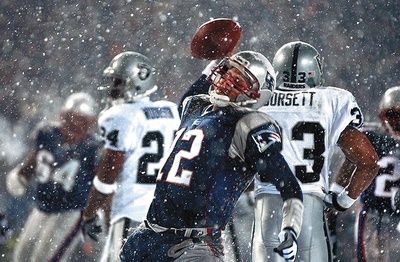The Tuck Rule is among the most infamous rules in the history of United States professional sports. A specific fan base should be grateful for the rule’s existence, while most NFL football fans probably wish the league’s rule-makers never thought of it.
But what is the official language of the Tuck Rule, and does it even still exist? Let’s go over everything.

NFL’s Tuck Rule, Explained
The Tuck Rule existed from its adoption in 1999 to its removal from the NFL rulebook in 2013. It wasn’t an official rule; rather, it was a technicality within the NFL’s language on distinguishing a forward pass from a fumble.
Here’s the official note from the NFL rulebook:
NFL Rule 3, Section 22, Article 2, Note 2. When [an offensive] player is holding the ball to pass it forward, any intentional forward movement of his arm starts a forward pass, even if the player loses possession of the ball as he is attempting to tuck it back toward his body. Also, if the player has tucked the ball into his body and then loses possession, it is a fumble.
The NFL’s competition committee voted 29-1 to repeal the Tuck Rule in 2013. The Pittsburgh Steelers were the only team to vote against the repeal, while Washington and the New England Patriots both abstained from voting.
Here’s what the rulebook now states:
Passer Tucks Ball. If the player loses possession of the ball during an attempt to bring it back toward his body, or if the player loses possession after he has tucked the ball into his body, it is a fumble.
Famous Tuck Rule Examples
The Tuck Rule was applied multiple times throughout its existence, but it’s infamous for one game in particular.
The Patriots trailed the then-Oakland Raiders late in a 2002 AFC Divisional Round matchup. New England’s Cinderella run — and Tom Brady’s impressive sophomore campaign — were nearing an end as snow fell at Foxboro Stadium.
During New England’s final drive, Raiders cornerback Charles Woodson strip-sacked Brady, and linebacker Greg Biekert recovered the fumble. Game over, Raiders win.
However, after reviewing the play, officials invoked the Tuck Rule while giving possession back to the Patriots. Adam Vinatieri eventually kicked a game-tying field goal as time expired in regulation and a game-winning field goal in overtime.
Brady and the Patriots went on to win their first Super Bowl, and the rest is history.
There are three other known applications of the Tuck Rule.
- 2001: Patriots vs. New York Jets (Tuck Rule in Jets’ favor)
- 2005: Washington vs. Denver Broncos (Tuck Rule in Broncos’ favor)
- 2010: Kansas City Chiefs vs. Baltimore Ravens (Tuck Rule in Chiefs’ favor)
Following the Chiefs-Ravens game, Mike Pereira, then the NFL’s vice president of officiating, said he no longer supported the Tuck Rule. Three years later, the rule met its long-awaited end.

